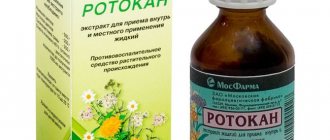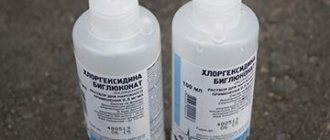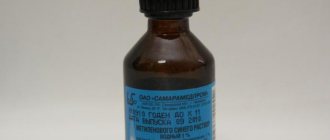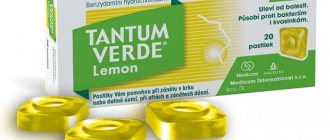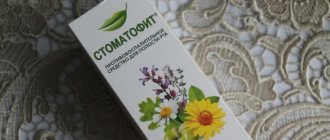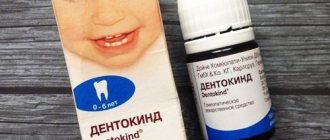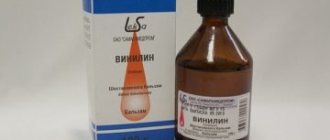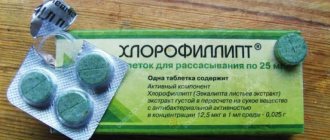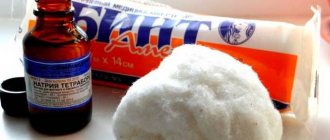How does furatsilin work?
Furacilin, consisting of nitrofural and sodium chloride, has pronounced antiseptic properties, so many believe that this is the best remedy for stomatitis. One of its main features is the ability to act on most bacteria known to medicine. For this reason, it is widely used for a variety of purposes, from treating wounds to gargling.
The drug not only eliminates symptoms; upon contact with pathogenic microflora, it dissolves the cell membrane, which leads to their death and a reduction in the number of colonies.
Several forms of the drug are used in different fields of medicine:
- solutions (alcohol, water);
- pills;
- ointment;
- aerosol.
In dentistry, solutions are most often prescribed - ready-made or prepared independently from tablets.
Furacilin ointment
- Often, when injuries occur to the tissues of the oral cavity (traumatic stomatitis), doctors recommend Furacilin ointment.
- Using this ointment is a fairly easy task; a thin layer of ointment is applied to the lesions.
- This ointment, of all active ingredients, contains only 2-3% of the active substance, but this is enough to have the necessary effect on the body.
- Microorganisms cannot develop protection against this remedy quickly, which is the main positive factor in the treatment of stomatitis.
- There is one limitation: this ointment is used from 10 years of age, so tablets of furatsilin are used for treatment of stomatitis in children.
Rinse with pharmaceutical drugs
Treatment with medications in the form of a rinse solution is one of the most common methods of treating almost all types of stomatitis. The remedy should be selected only by a doctor based on the clinical picture, age and general condition of the patient’s oral cavity. Pharmaceutical drugs are especially effective for the treatment of pathologies accompanied by inflammation, the formation of ulcers and aphthae. Read more about the forms and treatment of aphthous stomatitis in this material.
Furacilin
An extremely effective remedy in the presence of inflammation, as well as for the treatment of bacterial forms of stomatitis. Furacilin has a pronounced antimicrobial effect and helps reduce the level of inflammation. Suitable for children and pregnant women. It is advisable to rinse the mouth with a warm solution at the rate of 1-2 tablets per 200 ml of water. Read more about the treatment of stomatitis during pregnancy.
The procedures are carried out every 2 hours until a stable positive result is achieved. Do not allow the product to enter the esophagus, which can cause nausea. The course of treatment and dosage of the drug should be prescribed by the attending physician.
Furacilin solution is also used to prepare the oral cavity for subsequent surgery. It is believed that bacteria do not develop resistance to this drug.
Hydrogen peroxide
It is used for inflammatory processes in the oral cavity with bacterial forms of stomatitis, as well as for disinfection of affected areas. In all other cases, the drug is not advisable to use. To rinse, it is necessary to dilute hydrogen peroxide in warm water, otherwise there is a risk of burns and irritation of the mucous membranes. The procedure is carried out no more than 3-5 times a day, after consulting with a doctor.
It is not recommended for use by pregnant women and children, since the drug causes complications if the dosage is not followed. When interacting with baking soda, it is used to whiten enamel, but today there are more effective and gentle methods.
Miramistin
One of the few remedies recommended for the treatment of stomatitis even in infants. It has a wide spectrum of action, affecting many types of bacteria, fungi and virus strains. Miramistin for stomatitis helps to enhance the regeneration of damaged cells and stimulates the protective function. It is available in the form of a solution, spray and ointment, which is extremely convenient for use in a wide variety of cases.
Can be used as a prophylaxis for chronic forms of stomatitis; the course of treatment should not exceed 10 days. The duration of therapy and method are prescribed by the doctor. Before use, you need to carefully read the composition, as some patients experience an allergic reaction after use.
Potassium permangantsovka
Potassium permanganate, more popularly known as potassium permanganate, has a powerful antimicrobial effect, and until recently was one of the most popular and affordable disinfectants. The ability to kill bacteria largely depends on the concentration - for rinsing you need to prepare a weak solution, which can be distinguished by its characteristic pink color. According to the instructions, the procedure is carried out every 2-4 hours only after eating and brushing your teeth. Doctors almost never prescribe potassium permanganate, since there are more effective and safe medicines.
Today it is sold in pharmacies only by prescription, and if it enters the food tract, potassium permanganate can cause severe poisoning. It is not recommended for mouth rinsing for children who may accidentally swallow the solution. Pregnant women should use potassium permanganate with great caution.
Chlorhexidine
The most popular and affordable antiseptic. Suitable for rinsing the mouth for all types of stomatitis. A big plus of the product is that it can be used by children and pregnant women at any stage. The drug prevents the proliferation of pathogenic bacteria, slightly heals wounds and ulcers.
It is advisable to use chlorhexidine only after meals; the course of treatment is at least 10 days. It is strictly forbidden to allow the solution to enter the stomach, which can lead to poisoning and intoxication. It is also used as a prophylactic agent, as well as emergency measures, for example, for traumatic stomatitis. It is a classic remedy used in dentistry. Read more about Chlorhexidine rinses for stomatitis here.
Chlorophyllipt
The product has a pronounced antibacterial, antiseptic and anti-inflammatory effect. Available in the form of a spray, oil and alcohol solution for rinsing, as well as tablets. Chlorophyllipt is made from natural ingredients (base: eucalyptus and myrtle), making it safe for children and women during pregnancy.
For stomatitis, it destroys the population of pathogenic bacteria, strengthens the protective properties of cells and enhances the healing of affected areas. Rinsing can be done 4-5 times a day after eating and brushing your teeth. The duration of the procedure should be no more than 40 seconds.
The product has a pleasant smell and temporarily eliminates bad breath - halitosis. Some patients are allergic to the components of Chlorophyllipt, so if any symptoms appear, the product should be discarded.
General treatment tactics
Treatment of stomatitis is aimed primarily at eliminating the source of infection, healing ulcers and eliminating unpleasant symptoms. The first sign that people pay attention to is the formation of specific ulcers on the oral mucosa; in children, this process is often accompanied by an increase in temperature.
Ignoring the disease will worsen the severity of the inflammatory process.
Before prescribing treatment, patients are recommended to undergo laboratory testing: a general, biochemical blood test, urine test, and, if necessary, a saliva test for the presence of herpes simplex virus type 1.2 DNA, an immunological, allergological, and cytological examination.
We invite you to familiarize yourself with what types of dental prosthetics are there?
How to treat stomatitis:
- Mouth rinsing (irrigation with antiseptic, antimicrobial solutions, for example, Furacilin, rinsing with infusions of medicinal herbs with an anti-inflammatory effect).
- Applications of medicinal ointments and solutions to the affected areas.
- To relieve pain from mucosal lesions in adults, take anti-inflammatory drugs; for children, paracetamol and ibuprofen are prescribed.
- If necessary, antiviral medications (acyclovir), antihistamines to prevent allergic reactions and reduce itching (loratadine, desloratadine).
Treatment tactics depend on the etymology of the inflammatory process, its severity, the presence of background pathology, and chronic diseases. As a rule, the same algorithm is used for adults and children, but the doses of drugs, the intensity of their use, and the duration of the course of therapy change.
Ways and means
Stomatitis has many forms, it can be single small inflammations or extensive and deep ulcers. Depending on the degree of the disease, treatment tactics are chosen. Also, treatment methods are selected depending on the cause of the disease. Basically, stomatitis is treated at home after consultation with a doctor; it is a simple problem and often does not require hospitalization. After examination and tests, the doctor prescribes a number of medications aimed at pain relief, rapid healing, and support of the body. Such measures are sufficient if the patient has allergic, traumatic, catarrhal stomatitis.
Content:
- Ways and means
- Treatment at home
- Pain relief for stomatitis
- Which doctor treats stomatitis?
More common forms of the disease are herpetic and candidal stomatitis. They appear from the action of pathogens, are transmitted from person to person and are often recurrent in nature. Such forms of the disease often plague children and young people. Given the nature of this phenomenon, therapy is aimed at eliminating the cause of the disease and includes antiviral and antifungal drugs for oral administration. Also, inflammation in herpetic and candida forms occurs on the genitals, in this case treatment includes ointments and suppositories. In this case, the patient is prescribed all the necessary medications, which he uses independently and regularly visits the doctor.
Severe forms of the disease are treated in a hospital setting. The most common case is the ulcerative-necrotic type, which leads to extensive inflammation and deep erosions. Among the complications are general intoxication of the body through blood, loss of teeth, and deformation of the gums. Hospitalization is necessary because this condition is accompanied by fever, weakness, prolonged refusal to eat, and can be life-threatening if there are other severe pathologies. Also, small children may be admitted to the infectious diseases department if they suspect herpes or candidal stomatitis.
Despite the large number of drugs that help with inflammation of the mucous membrane, there is no single cure yet. Treatment tactics are selected individually for each person, based on the clinical picture. A considerable part of people prefer traditional methods: tinctures, decoctions, homemade ointments and inhalations. In the case of stomatitis, official medicine only supports this idea. An important condition is not to undergo treatment without consulting a doctor; often self-medication instead of help leads to chronic forms of the disease. Along with long-tested techniques, innovations are also used, such as laser therapy.
Medications
To treat stomatitis and eliminate its symptoms, oral medications are prescribed. The drugs are rarely prescribed to children, more often to adolescents and adults. For each group of patients, different drugs are used, taking into account the weight and age of the patient, and the form of the disease. A special group consists of infants, pregnant women and nursing mothers. They can use any medications only after a doctor’s recommendation, since even folk remedies may contain allergens.
Amoxicillin
A semi-synthetic antibiotic that fights the development of staphylococcus, salmonella, streptococcus and many other microorganisms. For stomatitis, it is prescribed if inflammation in the mouth is a secondary disease. Symptoms of stomatitis appear against the background of chronic diseases and severe weakening of the body, for example, from infection. Amoxicillin is prescribed to relieve the underlying problem. It is effective for aphthous, purulent, catarrhal types of disease. However, it does not help with herpes and vesicular types. The drug is used for adults, adolescents and children under 2 years of age. The dosage is strictly controlled by the attending doctor, especially for infants.
Amoxicillin tablets are also prescribed during pregnancy, but only if the disease threatens complications and cannot be cured by other methods. Women who are breastfeeding are contraindicated to take this medication. Taking any antibiotic, including this one, should only be done on the advice of a doctor. The effect of the drug is designed against internal foci of infection, as a result, wounds in the mouth heal faster, the patient’s well-being returns to normal, and the risk of relapse is reduced.
Other antimicrobial drugs for stomatitis:
- Sumamed is suitable for adults in the form of tablets, for infants - in the form of a suspension;
- Augmentin and Amoxiclav - contain Amoxicillin and clavulanic acid. Indications and contraindications are identical to Amoxicillin;
- Biseptol - suitable for children from three years of age only in the form of syrup; adults are prescribed tablets;
- Grammidin is a lozenge that has both an antibacterial and anesthetic effect. Children only from 12 years of age, pregnant and lactating as prescribed by a doctor;
- Flemoxin salutab is an antibacterial agent, approved for children from 2 years of age, the dosage is selected by the doctor;
- Diflucan, Fluconazole are antifungal agents, effective against candidiasis.
Tablets are also widely used to stimulate local and general immunity: Imudon, Interferon, Lizobakt. Homeopathy sometimes helps to develop immunity and get rid of the disease forever. Complex homeopathic composition Stomatito-gran, drink it from 3 to 9 months, but only with the permission of a doctor. For rapid tissue regeneration and ulcer healing, Methyluracil and Nystatin are prescribed.
Antiviral agents
A separate group consists of antiviral tablets. They are used for herpetic stomatitis and vesicular stomatitis. Acyclovir suppresses the replication of the virus, as a result, the patient’s tissue healing accelerates, pain subsides, and new erosions do not form. Used as first aid at the initial stage. Tablets are allowed to be taken by adults and children over 3 years of age. The dosage for adults is determined by the doctor; for children under 10 years of age, Acyclovir tablets are usually replaced with ointment. Children can also be prescribed procedures that involve treating the mouth: the tablet is diluted with sea buckthorn oil, then a cotton pad is dipped and the baby’s oral cavity is treated.
In case of severe disease, a child under 3 years of age is sometimes prescribed 100 mg tablets 5 times a day; older children are prescribed 200 mg 5 times a day. For adults, the minimum dosage is the same as for children. The use of this product by pregnant women and nursing mothers is contraindicated. Acyclovir is also not prescribed for elderly patients.
Analogues of the drug:
- Zovirax;
- Acivir;
- Kagocel;
- Acigerpin;
- Valavir;
- Biociclovir;
- Isoprinasine;
- Groprinosin;
- Normamed.
It is not recommended to replace Acyclovir on your own, since the prescribed dosage may be ineffective for another drug. In addition to antibiotics, antifungal and antiviral tablets for stomatitis, drugs are prescribed to eliminate symptoms: antipyretic, analgesic, anti-inflammatory, etc. Also, a complex of local treatment is necessarily added to the systematic therapy: ointments, sprays, suppositories.
Mouth rinse solutions
Oral hygiene plays an important role in the treatment and prevention of stomatitis. Patients are prescribed various solutions and mash for regular rinsing. This makes it possible to cleanse the oral cavity of microbes, act on erosion, and reduce itching and pain. Such remedies are prescribed even for infants; with the help of a prescribed solution and a cotton pad, the entire oral cavity of the baby is treated. Older children and adults are advised to rinse their mouth every 2-3 hours.
Rinse liquid:
- Derinat - available without a prescription, small children are supposed to wipe the cheeks, gums, lips and tongue with a swab every 2-3 hours. Adults - rinse. Suitable for herpetic, aphthous, enteroviral stomatitis.
- Candida in solution - suitable for candidiasis type of disease. Approved for wiping on infants, children over one year of age and adults.
- Borax in glycerin or sodium teraborate - used for infants from one month of age. Application: treat the entire surface of the mucous membrane with a cotton swab or disk; a cotton swab is not suitable for this.
- Miramistin - used for children of any age, for pregnant and nursing mothers. The application is the same: for children under 3 years old, wipe with a cotton pad; for adolescents and adults, rinse. Suitable for the treatment of bacterial and fungal stomatitis.
- Rotokan is created on the basis of medicinal herbs, is suitable for all groups of patients and is available without a prescription. Before use, be sure to read the ingredients and test on the skin, as the patient may be allergic to the components.
- Streptocide or sulfonamide. Used as a powder solution, one sachet is completely dissolved in a glass of water and rinsed in the mouth. Rubdowns are used for newborns and children under 2 years of age, but only as prescribed by a doctor. Children from three years of age are irrigated with the solution through a syringe without a needle.
A talker with complex action is also popular. To prepare, boil a glass of water, dissolve a Furacilin tablet in it, and boil again. Then you need to add one crushed tablet of Tetracycline and Streptocide to the solution, shake everything well. This composition is used to rinse the mouth every two hours during the acute course of the disease. Thanks to the components, the surface of the mucous membrane is sterilized, wounds heal faster, pain and itching are less, and swelling goes away. Also, an ampoule of Novocaine is sometimes added to the composition. For children, breastfeeding women and women in the mash position, it is better to use it only after the doctor’s permission. For pregnant women and during lactation, it is better to replace drug treatment with rinsing with decoctions of chamomile, nettle or sage.
Preparations for cauterization of ulcers
Cauterization of erosions and ulcers helps remove inflammation, prevents the spread of infection and promotes rapid healing. The wounds are cauterized only after rinsing and sterilizing the oral cavity; such treatment can only be carried out by adults; treatment is allowed for pregnant and lactating women. This treatment is not recommended for small children one year of age and younger. Used as medicine:
- Zelenka is the most popular remedy for treating any wounds. It is recommended that adolescents and adults use an alcohol-based solution, and children over 2 years old use an aqueous solution. First you need to rinse your mouth with one of the solutions described above. After this, apply brilliant green directly to the ulcer with a cotton swab or swab; you can repeat the procedure no more than 5 times a day. This cauterization pattern is typical for all medications.
- Iodine is also a very common remedy; it is used in the same way as brilliant green, but it can be applied to the mucous membrane no more than 3 times a day. For young children, it is better to replace iodine with blue or an aqueous solution of brilliant green. Also popular is Lugol's, which contains iodine.
- Streptocide paste - made from sea buckthorn oil and streptocide, applied locally to the affected areas of the mucosa. However, the use of such a remedy is not very convenient, so it is popular only for lesions on the skin.
- Hydrogen peroxide – for children and adults no more than 5 times per day.
- Fukortsin - for cauterization of pustules and ulcers from infancy.
- Blue - allowed for children from one year of age, but prohibited for pregnant and lactating women. It can also be applied to ulcers after rinsing, for children under 6 years old no more than 2 times a day, for older people 3-4 times.
For stomatitis on the skin of the hands and feet, such treatment methods are also used. Cauterization is rarely used for the treatment of stomatitis, since rinses and ointments perform the same function. But in the case of an acute course, a rapid increase in inflammation and the appearance of new ones, it requires enhanced treatment measures, in which case additional treatment of the wounds will help to heal faster. Hospitals and dental clinics use laser therapy for this purpose.
Ointment and gel
Stomatitis is a very common disease, so pharmaceuticals offer a lot of gels and ointments for treatment.
Such products immediately act on areas of inflammation, help relieve pain and itching, and have antiseptic properties. Also, some formulations are designed to speed up the healing process. Products for external use are especially effective for herpes, bacterial, and aphthous stomatitis. Depending on the symptoms, different drugs are selected, so treatment must be individualized. The use of these drugs is the same - external application after treatment with an antiseptic. Gels and ointments for stomatitis
| Name | Group of drugs | Indications (form of stomatitis) | Action | Additionally |
| Beneocin, Betadine | Antiseptic | All forms | Destroys harmful microorganisms, prevents the spread of infection, reduces itching, dries | Contraindicated after the 2nd month of pregnancy and for nursing mothers. Suitable for newborns and children, but strictly according to doctor's instructions |
| Vinilin (Shostakovsky balm), Clotrimazole | Antimicrobial, antiseptic | Candidal, traumatic, aphthous, ulcerative, catarrhal | Prevents the proliferation of microbes, promotes tissue regeneration and rapid wound healing | Not recommended during pregnancy and lactation, children under 3 years of age. Use only as prescribed by a doctor or instructions |
| Levomekol, Nystatin | Antibiotic, antifungal | Catarrhal, ulcerative-necrotic, aphthous, atrophic | Inhibits biosynthesis in microorganisms, prevents the development of disease and disinfects the surface | Acceptable during lactation and pregnancy in doses prescribed by the doctor |
| Metrogyl denta, Holisal | Antibiotic, antiseptic | Traumatic, catarrhal, herpetic, vesicular, Vincent | Quickly stops the development of the disease in the first stages, contains metronidazole and chlorhexidine | For adults and children from 6 years old. Before applying, it is recommended to remove the crust from the wound so that the gel penetrates deeper |
| Solcoseryl, Methyluracil | Biogenic stimulant, antiseptic | Any shape | Promotes tissue regeneration and rapid healing, suitable for application to any area of the skin and mucous membranes | For pregnant, lactating and newborns, use only as prescribed by a doctor is allowed, but may cause complications |
| Oxolinic ointment, Acyclovir, Viferon, Zovirax | Antiviral | Herpetic, vesicular | Stops the development of the disease, reduces inflammation and itching | Allowed in small doses (2 times a day) for small children |
Ointments and gels should be used after disinfecting the oral cavity. For all ages, sea buckthorn oil, a light solution of potassium permanganate or soda are suitable for this purpose. After rinsing or wiping, apply the product directly onto the wound, going slightly beyond its edges, to prevent the spread of infection. It is not recommended to use several ointments at once, as they may contain incompatible components. All creams and gels described are available without a prescription.
To get rid of ulcers on the tongue, palate or other parts of the mucous membrane, products in the form of gels are chosen. The gel lingers longer on the surface of the mucous membrane, and cream or ointments are preferable for the treatment of stomatitis on the arms, legs, face or genitals.
Candles
Candidal stomatitis often occurs in newborns and infants, especially in premature infants. Also, the herpetic type is very common among babies from 6 months. It is quite difficult to treat such patients, since most medications are contraindicated for them. If the disease is viral in nature, suppositories with a complex effect are prescribed; suppositories Viferon, Genferon, Kipferon are very popular. The active components of the suppositories are transported throughout the body through the bloodstream, thus reaching the location of inflammation. The drug has an antiviral effect, so its use is justified only for herpetic or vesicular stomatitis.
Also, suppositories are prescribed to pregnant women, Viferon - for viral infections, for thrush or candidal stomatitis - Pimafucin, Nystatin. Suppositories are used extremely rarely to eliminate stomatitis. You cannot set the dosage yourself, since the drugs contain active ingredients and can impair the immune system. Although rectal suppositories are available without a prescription, they should only be used after consulting a doctor.
Sprays
Sprays replace rinses and solutions in the treatment of stomatitis. This convenient form of the preparation allows you to spray the product evenly throughout the entire oral cavity, including treating areas of erosion. The spray is also needed if the inflammation is localized in the oropharynx or nasopharynx, tonsils, tonsils. Their composition is the same as all other drugs: antiseptics, antifungal and antimicrobial, painkillers, etc. This form of medication can be used from the age of 3, carefully selecting the composition for children and adults.
- for adults: Hexoral, Iodinol, Orasept, Strepsils Plus, Lugol;
- for children: Chlorophyllipt, Hexoral, Tantum Verde, Ingalipt.
When choosing a spray, be sure to pay attention to the composition. If the aerosol contains plant components, as in the Chlorophyllipt oil solution, this may cause an allergic reaction. Sprays are not recommended for pregnant and lactating women; it is preferable to replace them with mouth rinses using herbal decoctions.
The dosage for each drug and patient is individual, it depends on the age of the patient and the concentration of the active components.
Before spraying the medicine, be sure to rinse your mouth with boiled, cooled water. After using the spray, it is recommended not to drink or eat for at least half an hour. Like other drugs, aerosols are best used as prescribed by a doctor; in extreme cases, read the instructions carefully. You cannot use several aerosols at the same time.
Laser therapy
Laser is one of the progressive methods of treatment, including stomatitis. This method of therapy has shown effectiveness in eliminating viral, bacterial and fungal stomatitis. The procedure is carried out by experienced dentists after examination and tests. At the moment of laser exposure to the mucous membrane, the death of pathogenic microorganisms occurs. The beam destroys viruses, fungi and bacteria located intracellularly. As a result, the inflammation process stops, erosion heals quickly, pain and swelling disappear. In addition, after the procedure, blood circulation and metabolism in the oral cavity improves.
Laser treatment does not use medications, so the body does not experience unnecessary stress. This technique uses a very low intensity semiconductor beam. Therefore, the procedure is safe for humans and painless. This treatment is prescribed even to children from 6 years of age. The only exceptions are pregnant women. For complete recovery, the patient requires from 5 to 14 procedures. Due to the high cost, reviews show the low popularity of this method.
Hydrogen peroxide
The drug has the following properties: cleans the wound due to the chemical reaction of protein with hydrogen, disinfects, disinfects, stops bleeding.
For rinsing, adults are recommended to use a 1% peroxide solution. This concentration is enough to affect dirt and infection, at the same time, such a solution is safe for the mucous membrane. For the treatment of stomatitis, it is used not only as a rinse, but also for treating the affected areas with a cotton swab; for such manipulations, a 0.25% solution is preferable.
To prepare a solution using hydroperite tablets, 2 tablets of the drug will require 100 ml of water. Rinse for at least 5 minutes, do not eat food for half an hour after the procedure. Repeat rinsing at least 3 times, no more than 6. Due to the specific aftertaste, add a couple of drops of essential oil (mint, lemon).
The benefits of furatsilin for stomatitis
Basically, Furacilin is widely used for stomatitis in children, since it does not accumulate in the body, including in the blood. The drug is eliminated almost completely and in a short time. Thanks to this, most parents choose it when treating their children, so as not to undermine their children’s health with stronger and more harmful medications.
Furacilin is used for stomatitis because of its antiseptic effect. It acts on a large number of microorganisms, including gram-negative and gram-positive bacterial flora. Microbes are not resistant to the drug. Furacilin slows down the respiration of bacteria, which leads to their death. The inflammatory process stops, and the infection no longer bothers the patient.
Pros and cons of use
Despite the fact that this substance has a natural base, there are some features and contraindications to its use. That is why it is worth studying them before starting to use them.
The positive aspects include:
- the possibility of cauterizing stomatitis with iodine, which will prevent the penetration of unfavorable microflora and enveloping the inflammatory focus;
- fight against pathological microorganisms that may be present in children due to bad habits and poor hygiene
- providing an antiseptic effect for a long time.
Regarding the disadvantages, the following can be mentioned:
- It is not recommended to combine it with taking other antiseptic substances or alkalis;
- Treatment of stomatitis with hydrogen peroxide in combination with iodine is prohibited;
- to the question: can stomatitis be smeared with iodine? The answer is no, if you use it in its pure form.
- prolonged use may cause a local allergic reaction.
INTERESTING fact: The benefits and harms of beets for type 2 diabetes
For toothache
Furacilin is not an analgesic, however, in some cases it can be used as a means to reduce toothache. How effective it will be depends on the cause of the pain and how pronounced the pain syndrome is. In order to get rid of unpleasant sensations, you need to perform the following series of actions:
- Prepare a solution from tablets or use a ready-made pharmaceutical form.
- Heat the liquid to room temperature or a comfortable warm temperature.
- Rinse your mouth, directing the liquid towards the affected tooth.
- Hold the solution in your mouth for 30 seconds.
- Repeat rinsing after two hours.
Reference! In order to achieve a greater effect, it is worth taking an additional painkiller tablet. It would be a good idea to visit the dentist to determine the root cause of the pain.
After rinsing, the pain becomes less acute due to the fact that most of the pathogenic bacteria are destroyed. It is worth understanding that the procedure does not guarantee a complete recovery.
We invite you to familiarize yourself with White plaque on the tonsils (tonsils): what it is, symptoms and when you need to go to the doctor, methods of treatment and diagnosis of the disease
Rinsing process
For a more healing effect of furatsilin solution, you need to correctly follow the procedures when rinsing the mouth:
- Before starting the rinsing procedure, you need to rinse your mouth with a soda solution. This event will help remove accumulated mucous contents, which will improve the penetration and quality of the effect of the medicinal drug on the areas affected by the virus.
- Rinse every 2-3 hours. The procedure time between rinsing is no more than 2-3 minutes.
- After these procedures, many recommend applying medicinal furatsilin ointment, but strictly according to the recommendations of the attending physician.
The drug is in the form of an ointment
In some cases, furatsilin is prescribed in the form of an ointment. This treatment is usually used for traumatic stomatitis.
The drug in the form of an ointment contains 2% of the active substance, it has an antimicrobial effect, inhibits the growth of fungal flora, and is active against large viruses. Microorganism resistance to the product develops slowly and never reaches a high degree.
It is recommended to apply the ointment to the affected mucous membranes in a thin layer twice a day. The drug is used mainly to treat adult patients and children after 10-12 years of age. The drug should not be used if you are hypersensitive to nitrofural.
Chamomile
Chamomile decoction has antiseptic, anti-inflammatory properties, soothes inflamed mucous membranes. For preparation you need 2-3 tablespoons of dry plant. Pour a glass of boiling water over chamomile, let it brew for about half an hour, rinse your mouth 5-6 times a day.
When the question arises, how to rinse your mouth with stomatitis in adults, it is important to take into account the degree of the disease, the cause
stomatitis
, individual tolerance of the drug in the patient. Whether to give preference to traditional medicine or pharmaceutical products must be decided individually, taking into account the recommendations of the attending physician.
Rinse for stomatitis in children - features
In case of childhood stomatitis, gum inflammation can be treated from 1.5 years of age, since it does not require throwing back the head. The procedure must be carried out under the careful supervision of an adult; before it, the child must be explained how to properly treat the oral cavity and teeth. It is important to convey that the solution should not be swallowed.
Sometimes, when using drugs containing herbal ingredients for treatment, there is a possibility of an allergic reaction to them. Therefore, before rinsing for stomatitis, it is necessary to stock up on products that have an antihistamine effect; these should be drugs that can be given to children.
It happens that allergies are accompanied by swelling of the oral cavity. In such a situation, you will need to call an ambulance as soon as possible, since swelling can provoke an acute attack of suffocation, which in some cases leads to death.
If you plan to use traditional medicine when treating your baby at home, make sure that the attending physician has no contraindications for such treatment, because the doctor will prescribe traditional medicines, in combination with which the folk remedies should be compatible and not cause side effects and inflammation in the cavity mouth and teeth.
Soda
Gargling with soda is an effective remedy for stomatitis.
Rinsing your mouth with soda is the most common remedy for stomatitis. Soda relieves pain, inflammation, irritation, promotes the healing of aphthae, and disinfects the surface of the oral cavity.
One teaspoon of baking soda should be diluted in 100 milliliters of warm water. Rinse your mouth with the resulting solution three times a day. You can also wipe the inflamed mucous membrane with a gauze swab dipped in a soda solution.
Application
Treatment of mouth ulcers with brilliant green is carried out in the following way:
- purchase a 1% solution;
- dip a cotton swab in it;
- cauterize only the affected area with a soaked stick;
- if it is necessary to smear the child’s ulcers, use an aqueous solution instead of an alcohol solution;
- It is necessary to apply the product to the affected area, lightly touching it so that the brilliant green burns less;
- after the sores are green, hold your mouth open for about three minutes until the solution is absorbed;
- should be re-treated 2-3 times a day for three to five days.
Iodine helps with stomatitis if you use it in the form of rinses or make lotions from it. Rinse the mouth with a one percent solution of molecular iodine three times a day. Lotions in the form of applications are made as follows: moisten a gauze swab in a solution and apply it to the area of ulcerative lesions for a minute or two. The duration of treatment is on average two to three days.
You can make blue iodine yourself at home
For the treatment of stomatitis, blue iodine is used, which can be made at home. To do this, you need to take 50 ml of boiled water and dissolve a teaspoon of sugar and starch in it, add a gram of lemon. Add the mixture to 150 ml of pre-boiled water and stir. The resulting medicinal liquid is cooled and a small spoon of iodine is added to it.
"Iodinol" for stomatitis can be used as follows:
- dilute the drug with water in a ratio of one to two and smear it on the affected areas of the mucous membrane;
- in case of herpetic stomatitis, it is used to soften the crusts that have formed; for this, iodine is applied with a cotton swab to the sores and wait a few seconds, after which they try to carefully remove the crusts.
The product and its use
If the oral cavity is affected by the herpes virus, treatment is carried out in a complex, with local therapy prescribed.
For those who are too small, soak a tampon in furatsilin and treat the affected areas of inflammation. For older children, use mouth rinse.
- It is not difficult to create this drug on your own; for this you need to purchase furatsilin tablets at any pharmacy.
- In this case, it is necessary to pay attention to the dose of the drug. The main doses of the drug in pharmacies:
- It is very important to be able to prepare an antiseptic solution correctly:
- Furacilin tablets have the ability to dissolve slowly in water, so it is advisable to crush them to a powder state before this action.
- To prepare the completely necessary solution, use distilled water or regular boiled water.
- The most effective way to dissolve tablets is to heat the liquid to 39*C. You should not heat it higher, as the product will lose most of its beneficial properties.
- To a 200 ml glass of water, add one tablet of 0.02 g or two tablets of 0.01 g of furatsilin.
- Before starting the rinsing procedure, carefully inspect the contents of the glass for undissolved grains of the medicine. If they are detected, stir the rinse mixture for another 2-3 minutes.
- You can use gauze to prevent undissolved grains of furatsilin from entering the human gastrointestinal tract. To do this, you need to fold the gauze in half and strain into another glass.
We invite you to familiarize yourself with the AYURVEDIC ORAL CARE PROCEDURE - GANDUSHA (OIL RINCHING)
It would be best to prepare this rinse solution in small doses and use it warm.
It is permissible to prepare this solution in reserve, for one liter of water - 10 tablets with a dose of 0.01 or 5 tablets of 0.02 g.
The finished product can be poured into a clean container and placed in the refrigerator for long-term storage. Before each rinsing procedure, the solution is poured into the required container and heated to 39*C.
To enhance the effect of the rinse composition (furacilin 220 ml), add to it:
- A teaspoon of hydrogen peroxide 3% (hydrogen peroxide);
- Calendula in the amount of 12 drops or propolis in the same amount.
Furacilin for stomatitis in children should not contain alcohol-containing additives; for adults, such additive material is most suitable and brings good results in treatment.
How to dilute Furacilin tablets for adults
For local and external use, use an aqueous solution of 1:5000.
Here's how to prepare a solution of Furacilin 1:5000:
- Boil the water.
- Measure out 100 ml of water. Or keep it simple - fill a 200-gram glass halfway.
- Place 1 tablet in 100 ml of water.
- Stir until completely dissolved.
To prepare an alcohol solution, Furacilin must be diluted in 70% alcohol. To make a 70 percent alcohol solution, follow these instructions:
- Measure out 66 ml of rubbing alcohol (96%).
- Add 34 ml of boiled or distilled water to it.
If you don't have precise measuring containers, keep it simple and mix 2/3 rubbing alcohol with 1/3 water.
Furacilin should be diluted in the resulting 70% alcohol in a ratio of 1:1500 according to the following instructions:
- Take 33 ml of warm 70% alcohol.
- Place 1 tablet in the alcohol solution.
- Stir until completely dissolved.
Nitrofural dissolves better in alcohol than in water. However, the alcohol solution will also have a suspension of small particles. The lack of transparency of the solution does not indicate its poor antimicrobial properties.
Before developing a treatment regimen for inflammation of the oral mucosa, it is necessary to accurately determine their etymology, otherwise the effectiveness of the prescribed drugs will be very low or zero. There may be several causes of stomatitis:
- result of injury (traumatic stomatitis);
- infection with a virus (herpes type 1.2, enteroviruses, etc.), bacterial infections;
- autoimmune, manifest as a symptom of pathology of internal organs (Behcet's disease - Adamantiad, Kawasaki, ulcerative colitis, etc.);
Much less often, inflammation of the oral mucosa in combination with other specific symptoms may indicate the possible development of a tumor (carcinoma), allergic diseases (chronic recurrent aphthous, allergic stomatitis, etc.).
It is important to take into account the presence of additional symptoms, in addition to ulcerative lesions: increased body temperature, inflammation of the nasopharynx, sublingual tonsil, development of erosion of tooth enamel, as well as age, nationality, the number of stomatitis in the history or fixation of the first manifestation, the vaccination status of the patient. This will help to accurately determine the severity of the inflammatory process, its causative agent, and select the most effective medications.
Stomatitis causes a lot of inconvenience, regardless of whether it manifests itself in an infant or an adult.
In order not to let the situation get worse and prevent the oral cavity from becoming seriously infected, it is recommended to treat inflamed surfaces with antibacterial compounds.
For example, Furacilin is effective for stomatitis; the solution can be easily prepared even at home.
For greater effectiveness, Furacilin solution is recommended to be used throughout the day.
Before treating the oral cavity with this product, it is recommended to use a soda solution (1 tsp baking soda for 1 glass of water).
Rinsing with a soda solution will help remove mucus deposits, and the Furacilin solution will be provided with easy access to the areas affected by inflammation
There are also features in using the solution that depend on the age category of patients:
- Adults and older children. Furacilin for stomatitis in adults is used as a mouth rinse for 5-10 minutes, gradually sipping from a glass. The procedure must be carried out every 2 hours;
- Infants and toddlers. You will have to treat your gums for stomatitis. Mom wraps a little sterile cotton wool around her finger, moistens it with Furacilin solution and wipes the inflamed areas. The procedure must be carried out after each feeding.
To consolidate the therapeutic effect, it is also recommended to use an ointment based on it for stomatitis after treatment with Furacilin solution.
on this topic
Furacilin avexima
Avexim effervescent tablets are convenient because they allow you to quickly dilute Furacilin. Sold in packs and tubes of 10-30 tablets.
In addition to nitrofural and salt, effervescent tablets contain additional substances:
- Wine acid;
- soda;
- macrogol (polyethylene glycol).
In accordance with the instructions for Furacilin Avexim, macrogol, which is part of it, can cause allergic reactions (rarely).
To prepare a rinsing solution, use 1 tablet per 100 ml of warm water.
Furacilin solution for stomatitis
Ready-made formulations can be purchased at pharmacies. Once opened, they can only be stored in the refrigerator for no longer than ten days. The second option is to prepare the solution yourself from tablets. The procedure is as follows:
- Take a 0.02 gram tablet (or two 0.01 grams each) per glass of water.
- The tablets need to be broken into several parts, then ground into powder.
- The water is heated to a temperature of 30 degrees. If the temperature is higher, the medicine will lose some of its properties.
- Dissolve the drug in water.
The prepared solution can be purchased at the pharmacy.
It is not recommended to use the prepared liquid immediately. It should stand at room temperature for 3-4 hours, after which it must be filtered using cotton wool or gauze folded in several layers. Before use, the required amount of solution is heated, but not more than 40 degrees.
There is no need to prepare a large volume of solution at once! The shelf life is 10 hours; it must be stored refrigerated in a closed glass container.
Another method is treatment with an alcohol solution, recommended for the formation of ulcers (ulcers). It contains ethyl alcohol (70%) and furatsilin (three tablets). The resulting liquid is infused for at least three hours. You cannot rinse your mouth with this composition; it is used to cauterize ulcers with a cotton swab dipped in the solution.
The use of an alcohol solution is contraindicated for children, pregnant and lactating women.
To increase efficiency, other components can be added to the solution:
- calendula tincture (a few drops);
- hydrogen peroxide (teaspoon per glass);
- essential oils of juniper and tea tree.
"Furacilin avexima" are effervescent tablets that dissolve quickly.
Due to the popularity of the drug, other forms are also available. Not long ago, the drug “Furacilin avexima” appeared, which is an effervescent tablet designed for rapid dissolution. They contain auxiliary substances - sodium carbonate and bicarbonate, tartaric acid and others that facilitate dissolution.
One tablet of the product is diluted in 100 ml of water. It is advisable not to store the resulting solution, but to prepare it before use. To prepare an alcohol solution, mix two parts alcohol and part water. The tablet is diluted in 330 ml of the resulting mixture.
Furacilin for pharyngitis
The main provoking factors in the development of pharyngitis, that is, inflammation of the throat, are inhalation of cold or dirty air, as well as various chemical irritants. Infectious pharyngitis can develop due to the development of fungi, microbes or viruses. Most often, the disease develops due to the spread of an infectious process and can appear together with rhinitis, sinusitis or caries.
The use of furatsilin for pharyngitis helps to remove microbes, as well as speedy healing of the mucous membranes. Rinsing with furatsilin solution is not monotherapy, but part of a complex treatment!
Gargling with calendula for sore throat
The main goals and objectives of the solution:
- cleansing the mucous membrane of purulent deposits. Neutralization of viruses, bacteria and fungi leads to a decline in the inflammatory process;
- removal of the formed purulent plug, which is a breeding ground for the proliferation of pathogenic microflora;
- creating conditions in which pathogens cannot reproduce;
- softening and moisturizing the mucous membrane;
- reduction of pain and discomfort;
- acceleration of the regenerative abilities of the mucous membrane.
You can read about how to rinse your nose with furatsilin in this article.
conclusions
Stomatitis is an unpleasant phenomenon that causes great discomfort to the patient and is accompanied by pain when eating, as well as at rest. This disease is accompanied by the formation of painful ulcers on the gums and inner surface of the cheeks.
The causes of stomatitis can be very diverse, from mechanical damage to the oral mucosa to the development of an autoimmune condition. Regardless of the cause of stomatitis, an important point in therapy is antiseptic treatment of inflamed lesions. "Furacilin" is the most optimal choice for disinfecting the oral cavity.

